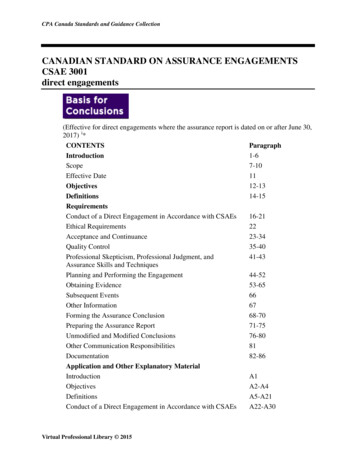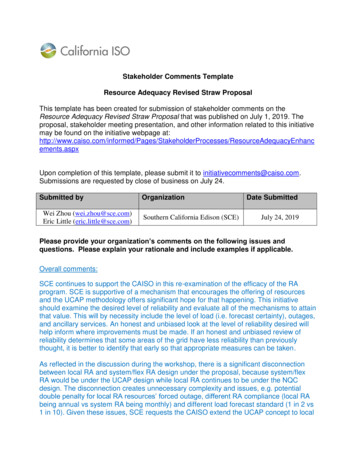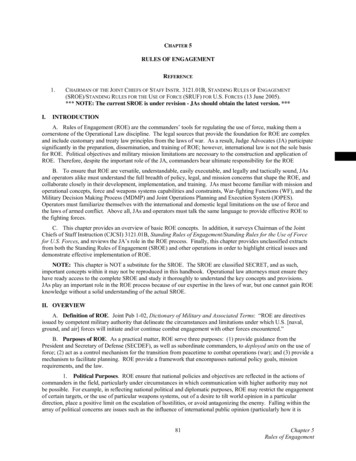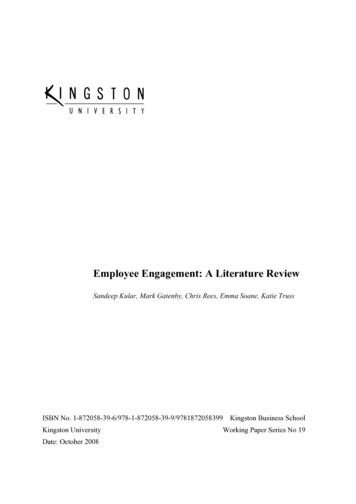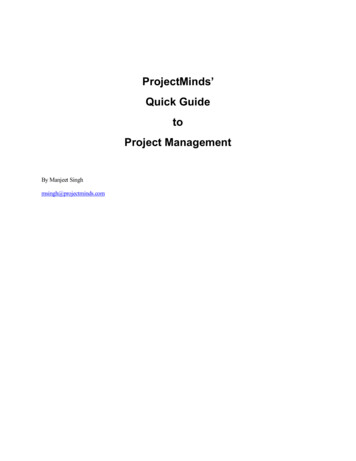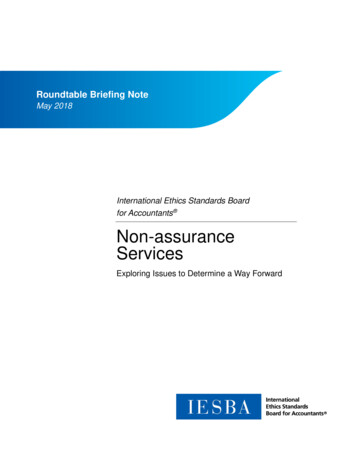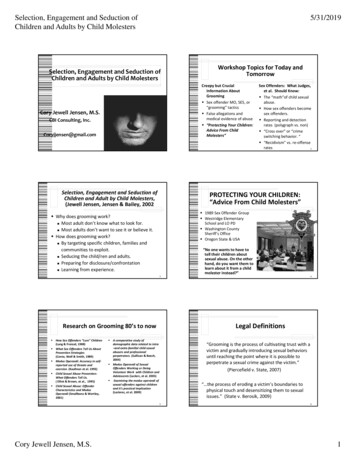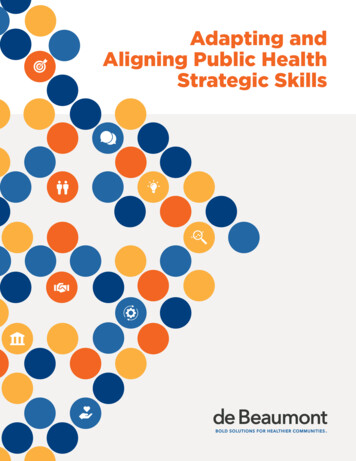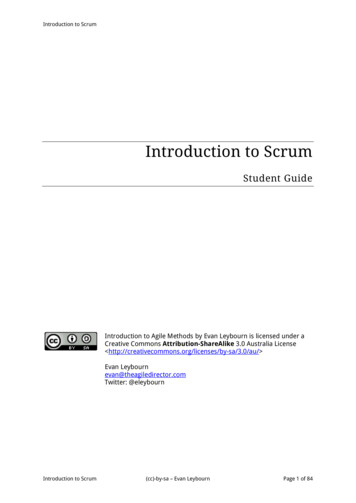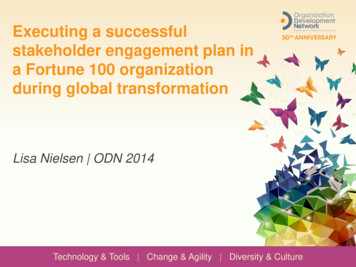
Transcription
Executing a successfulstakeholder engagement plan ina Fortune 100 organizationduring global transformationLisa Nielsen ODN 2014Technology & Tools Change & Agility Diversity & Culture
Objectives for today’s session Learning Objectives:Page 4 How to plan for stakeholder engagement across a global,federated organization with over 3,000 impacted stakeholders Top five lesson’s learned on how to execute a successfuldeployment of the stakeholder engagement strategy How to measure stakeholder engagement supports trends tomitigate against adoption risks
Client Situation&Project Objective.
Client Situation6 OpCos20 countries91 deployments3,000 end users64,000 employeesThe project objective was to establish a new Governance, Risk and Compliancesolution within the Information Risk Management group globally across theorganizationPage 6
Concerns over the project prompted a requestfor specialized change supportProject Impact The project would bringchanges resulting in useof new tools, process andbehavioral changes Page 7Support request prompt The sponsor of the project was concernedabout negative feedback (moving timelines,lack of communication, credibility concerns)she was hearing about the projectThe project team was concerned that the project’s DecisionReview Board was wavering in support for the project andmight not approve the project to continue into the next phase(currently in “design and plan” preparing to move to “buildand deploy.” 5M had already been invested)
Current State AnalysisData gathering to understand the current state Project team member &stakeholder interviews Review of all existing projectdocuments, SharePoint site, andpublic communication materialCurrent state findings andrecommendationPage 8 Participation in currentproject workshops
Assessment findingsStakeholder Engagement, Impact & Readiness, and TrainingStakeholder EngagementImpact & ReadinessEstablish a clear vision andcase for changeDevelop and deploy ChangeImpact AnalysisComplete stakeholder analysisManage Change ImpactAction PlanTrainingIdentify training development anddelivery coverageIdentify traineesCreate logistics strategyEngage leadership teamsDevelop and deploy ChangeReadiness Assessment strategyEstablish change agent networkDesign User Acceptance TestingDevelop and deploystakeholder Pulse CheckDevelop communication planIdentify and track changesuccess metricsIdentify delivery channelsProvide input to postimplementation support planIdentify environment and useaccessIdentify and train instructorsMap training rolesDesign training curriculumIdentify delivery channelsCurrent state of Change Support ActivitiesPage 9Currently ExistsPartially ExistsDoes not exist
Group ExercisePrompt – 2 minutes Based on these assessment findings, what type of strategy would youbuild and propose to your client to boost stakeholder engagement andsupport adoption of the change? Where would you start?15 minutesSmall Groups – 8 minutes Break into small groups of 4-5 Capture a list of your major workstream focus areas and where you would startworking firstReport Out - 5 minutes Group report outPage 1010
It is easy to underestimate the importance ofbuilding commitment to changeTimeBased on our initial analysis, we believed theproject was at a critical juncture betweenawareness and confusion. If this is not remediated,the gap between commitment and rejectionwould continue to widenCommitmentCommitmentCommitofLevelLevel renessInformUnawarenessConfusionSource: Adapted from ODR, Inc.Page 11NegativeperceptionDecision not tosupport changeSupportBest case:complianceRejectionwithdrawnWorst case: rejectionafter use
Simon Sinek’s perspectiveHow?What?Why?The project teamhas beenfocusing oncommunicatingthe “what,” butnot the how orthe why? Without the ‘why’ stakeholders did not see a reason for this change Without the ‘how’ stakeholders were feeling anxious about timelines As we know from David Rock’s work, author of Your Brain at Work,uncertainty is an even greater threat (as perceived by the brain) thanknown negativesPage 12
Immediate actionOur very first intervention was to work with the team to identify the valuedrivers, the ‘why,’ of the projectCurrent state poses Lack of visibilityinto enterprisewide state ofcomplianceBusinessChallengesFuture State Creates visibility into the enterprise state ofcomplianceProvides a single source for gap findings,remediation evidence, and exception requestsLittle to noaccountability orconsistency inperiodiccompliancechecksProvides enhanced near-real time reportingand standardization of metricsPromotes end user accountability andreduction of costly pre-audit swat teamsCostly and distractingswat team constructionfor audit preparationand post auditremediationPage 13Nonintegrated Legacysystems causing timeconsuming, manualworkflowsEnables increased resourcing efficiency andsupports to proactive compliance
High level strategyThe remainder of the change strategy was made up of three workstreams tosupport commitment to the GRC programChange WorkstreamsStakeholder Engagement1 and End-userCommunicationsWorkstreams drive commitment through Identifying and addressing key stakeholder’s concerns will producevisible leadership commitment Communicating to help build understanding of and commitment tochange among impacted audiences Identifying change impacts, risk areas and readiness activities willenable smooth transition and improved commitment to future state2 Impact and Readiness3 Training Tracking key metrics will provide the change team early visibilityinto business readiness and user adoption so they can alter plansto drive greater commitment Training will enable end users to develop the behaviors, skills,capabilities and knowledge required to effectively perform newways of workingEach workstream was detailed in subsequent sections of the strategy regarding itskey activities, principles of approach and development areasPage 14
Engagement strategyBuilding a holistic stakeholder engagement strategy to cover all strata ofthe organization from the CIOs to the end-userStakeholder Engagement ActivitiesCIOsandDRBAdvisoryCouncil:20 Regional ITManagers acrossall OpCosDeploymentCoordinatorNetwork:92 IRMCoordinatorsEnd Users:Approximately3,500 across thecompany globally CIO meetings: 1:1 meetings held with Decision Executive to gain CIO commitmentto deploy by Q2 2016 DRB meetings: 1:1 and group meetings to oversee progress of the GRC projectand approve phase gates and go liveStakeholder Engagement Activities Advisory Council & Change Agent Network meetings: a forum to providethe Core Team feedback and explain deployment tasks Usability Testing: Validate the ease of use and intuitive nature of the UserInterface Live demo and Impact Analysis: Review tool functionality; capture impactdata on what is changing for training Functionality Walk-throughs: Walk-through of Archer GRC functionalityand new processesStakeholder Engagement Activities Functionality Walk-throughs: Walk-through of Archer GRC functionalityand new processes Usability Testing: Validate the ease of use and intuitive nature of theUser Interface Awareness Sessions: Pre- go live presentations to introduce ArcherGRC, direct users to training and where to get help after go livePage 15
Impact & ReadinessIn addition to stakeholder engagement, impact and readiness measureswere an essential part of our change support strategyImpact Analysis Accurately understanding the impactsproposed changed would bring to variousstakeholder groups was essential toestablishing meaningful mitigations such asdesign changes or training focusesPage 16Readiness Pulse checks As we will see if the top 5 lessons learnedsection, being able to quantify stakeholdersupport lends the project enormous credibilityto decision makers and an ability to trackprogress
Top 5 Lessons Learned
Light Many Fires – Herb ShepardYou can’t be everywhere to deliver a passionate soliloquy on the case forchange, nor should you be. Pilot your change with Early Adopters and findinternal supporters who share your vision18
Create an interactive cross-functional AdvisoryBoard Make meetings as interactive as possible;ask “how are we doing?” constantlyDo not allow meeting time to be used forpush status updatesFight the urge to defend against dissentCreate opportunities to make decisions inreal timeCoach your core team to considerconcerns their early warning systemThe purpose of the Advisory Council is to create a forum to provideBU/OpCo/department feedback for the voice of the customer and toprovide input to the core team on key decisions19Page 19
Change Agent NetworkChange Agents need to communicate in all directions as they receiveproject information and provide feedback from their stakeholders Interacts with CIO to gaincommitment to supportGRC programEndorser Provides overview to ITManagers and passesfeedback to change teamDecisionExecutive The source of content forboth end-user comms andkey stakeholderengagementGRCChangeTeam2Core GRCTeamMemberOpCoInformation FlowCIOIT ManagerDeploymentAdviser3 Interfaces with assignedCA member to passalong toolkit andcomms Collects data, reportsand feedbackChangeAgent91InformationSteward(End-User) Receives business caseinformation from Endorser Interacts with IT Managersto relay support anddiscuss program issues Receives high-level infofrom Decision Executive Interacts with CA for detailedreport and escalates issuesto CIO as needed Communicate GRC projectinformation down toInformation Stewards,across to other IRMCoordinators and up totheir IT managers/CIO’s Receives information andtraining from CA Provides feedback, metricsand data3,00020Page 20
Keep a visual record of your progressMayAssessJuneJulyAugustSeptStakeholder Management & People Readiness pre-go liveOctNovDecTransitionCollect pre-goCollected InitialLaunched Change Agentlive metricsbaselineNetworkGained commitmentpeople metricsto deploy from CIOsTable TopdeploymentChange Strategy /planningPlan established andOpCo deploymentsocializedplanningUsability & UATtestingEnterprise go liveCollected Impact1:1 meetings with DRB Assessment datamembers; passedBCM NeedsthroughPhase Gate 3Advisory CouncilAnalysisinto Phase 4 July 25establishedBenefitscommunicatedto DRBEspecially in long-term projects, people will forget how far you’ve come! Also,decision makers may change, so the more you document your journey the lesstime they spend suggesting old ideas or struggling with previous decisions21Page 21
AssessmentAssessmentofof levellevel ofofAwarenessofAwarenessofGRCGRCAssessmentof level ofSupport forGRCBoth measures of awareness and support wereincreased between the baseline and go liveUse Success Metrics to validate improvementTracking metrics to measure the level of support across the stakeholder communitycomes in very useful when CIOs want to know if the project is supported22Page 22
Group DiscussionPrompt Which of these top five learnings have you used in your ownengagements? What has worked well for you? Are there any recommendations you have used successfully that are noton this list?Page 2323
Contact Information Lisa Nielsen, MA OD People & Organization Change Consultant,Ernst & Young Lisa.nielsen@ey.com (415) 524-3274Presentation title#ODN14
Please Complete a SurveyBefore You leave!Your feedback is greatly appreciated.Thank You!#ODN14
Functionality Walk-throughs: Walk-through of Archer GRC functionality and new processes Usability Testing: Validate the ease of use and intuitive nature of the User Interface Awareness Sessions: Pre- go live presentations to introduce Archer GRC, direct users to training and
